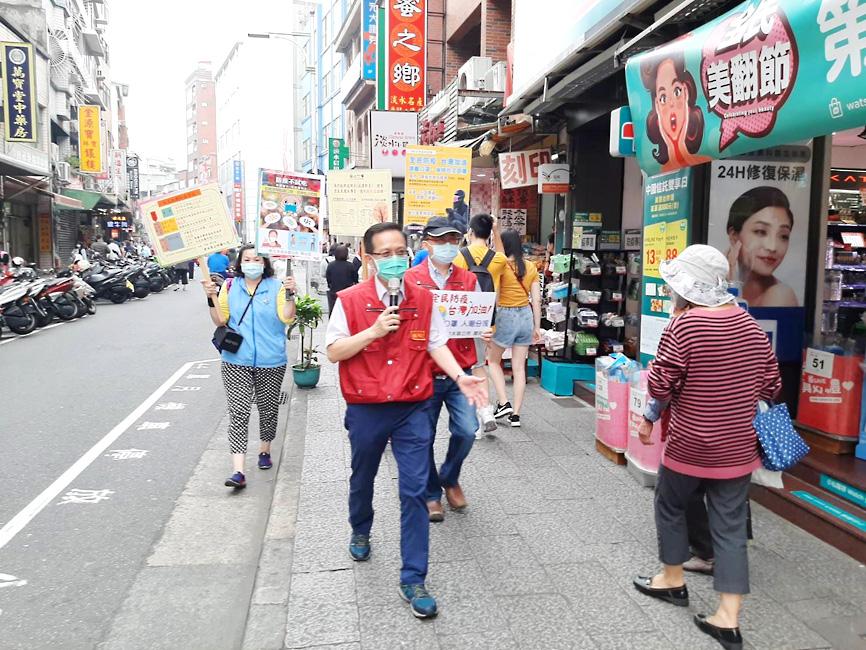The damage from the COVID-19 pandemic to economies in the Asia-Pacific region could reach US$2 trillion through next year, S&P Global Ratings said on Friday, as the coronavirus persists and the recovery of business conditions to pre-pandemic levels looks some way off.
The implementation of social distancing and other containment measures would continue in a bid to mitigate the effects of the outbreak until an effective vaccine is developed, but such practices will likely cause income losses for households and businesses, it said.
“As the COVID-19 pandemic endures, we are learning more about its human, economic and financial costs,” S&P Global Ratings Asia-Pacific chief economist Shaun Roache said in a statement. “The next lesson will be about the cost of transition between lockdown and vaccine.”

Photo: Chen Hsin-yu, Taipei Times
Economies in the region would enter a transition period until the middle of next year, during which social distancing measures would pervade in everyday life, although such constraints might differ by country and could be relaxed or tightened from time to time depending on the epidemic situation, the ratings agency said.
“Economic policies can limit some of the damage during first-wave containment, support the partial recovery through transition, and provide a bridge to the self-sustaining recovery that takes hold in late 2021. However, the costs continue to compound,” it added.
Based on S&P’s estimate, economic growth across the region would slow to 0.3 percent this year, which compares with 4.8 percent growth the agency forecast prior to the pandemic and marks the lowest since the 1.3 percent growth during the Asian financial crisis in 1997.
The IMF last week said that economic growth in the region will likely slow to a standstill this year, which has not happened in the past 60 years.
S&P said that Taiwan’s economy would shrink by 1.2 percent this year, down from its previous estimate of 1.9 percent expansion.
The ratings agency said it expects China’s economy to grow 1.2 percent, down from the 2.9 percent growth it projected earlier.
The agency cut its growth forecast for India from 3.5 percent to 1.8 percent and expects Japan’s economy to contract by 3.6 percent, compared with a decline of 1.2 percent it predicted earlier.
Governments in the region are facing imminent challenges, such as unemployment, from the pandemic, which would cause consumers to become more frugal, increase pressure on more leveraged households and take a toll on the broader economy, S&P said.
“From an economics perspective, the main risk now is unemployment,” Roache said. “Jobs are easily lost, but hard to win back and a surge in unemployment, say by more than 4 percentage points across the region, would mean a much flatter recovery path.”

Intel Corp chief executive officer Lip-Bu Tan (陳立武) is expected to meet with Taiwanese suppliers next month in conjunction with the opening of the Computex Taipei trade show, supply chain sources said on Monday. The visit, the first for Tan to Taiwan since assuming his new post last month, would be aimed at enhancing Intel’s ties with suppliers in Taiwan as he attempts to help turn around the struggling US chipmaker, the sources said. Tan is to hold a banquet to celebrate Intel’s 40-year presence in Taiwan before Computex opens on May 20 and invite dozens of Taiwanese suppliers to exchange views

Application-specific integrated circuit designer Faraday Technology Corp (智原) yesterday said that although revenue this quarter would decline 30 percent from last quarter, it retained its full-year forecast of revenue growth of 100 percent. The company attributed the quarterly drop to a slowdown in customers’ production of chips using Faraday’s advanced packaging technology. The company is still confident about its revenue growth this year, given its strong “design-win” — or the projects it won to help customers design their chips, Faraday president Steve Wang (王國雍) told an online earnings conference. “The design-win this year is better than we expected. We believe we will win

Chizuko Kimura has become the first female sushi chef in the world to win a Michelin star, fulfilling a promise she made to her dying husband to continue his legacy. The 54-year-old Japanese chef regained the Michelin star her late husband, Shunei Kimura, won three years ago for their Sushi Shunei restaurant in Paris. For Shunei Kimura, the star was a dream come true. However, the joy was short-lived. He died from cancer just three months later in June 2022. He was 65. The following year, the restaurant in the heart of Montmartre lost its star rating. Chizuko Kimura insisted that the new star is still down

While China’s leaders use their economic and political might to fight US President Donald Trump’s trade war “to the end,” its army of social media soldiers are embarking on a more humorous campaign online. Trump’s tariff blitz has seen Washington and Beijing impose eye-watering duties on imports from the other, fanning a standoff between the economic superpowers that has sparked global recession fears and sent markets into a tailspin. Trump says his policy is a response to years of being “ripped off” by other countries and aims to bring manufacturing to the US, forcing companies to employ US workers. However, China’s online warriors